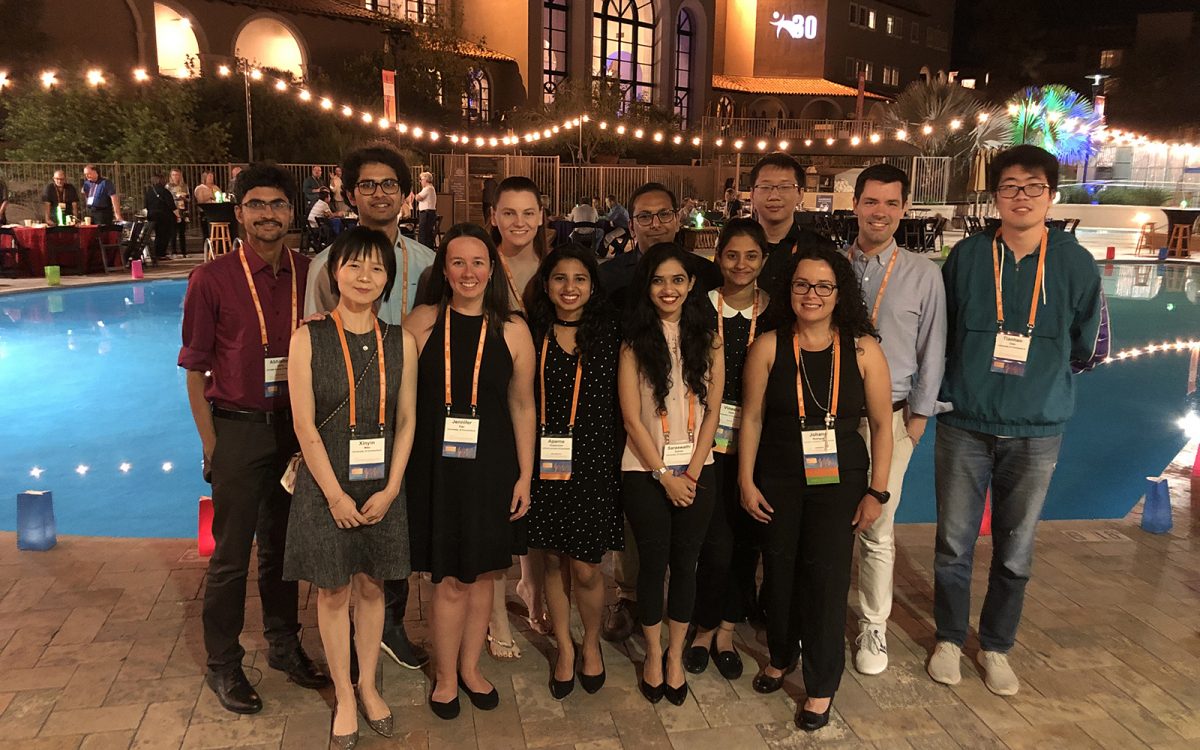
If a pet-adoption agency wants to quickly find a home for a puppy, is it better to post a picture of the pup with its littermates—or a series of photos of the dog alone?And if soccer club owners are trying to identify which FIFA players are underpaid based on their talent, could they accurately do so by analyzing public data about each player’s skill ratings?
Two teams of UConn graduate students used their predictive modeling expertise to successfully answer those questions, and their conclusions led them to tie for first-place in a national, statistical-software competition. Their awards were presented at the JMP Discovery Summit in Tucson, Ariz., last month.
Class Project Turned Into Networking Dream
The predictive analytics project began as an assignment in OPIM Professor Jennifer Eigo‘s classes in Hartford and Stamford last spring. When she learned about the JMP Discovery Summit, she urged students to consider refining their projects over the summer and submitting them to the competition.
The opportunity to attend the conference, which drew some 1,000 people, including top analysts from Exxon, Proctor & Gamble, Apple, Nike, Boeing, GM, Samsung and Abbott Laboratories, was a tremendous networking opportunity for the students, Eigo said. She was impressed to see her students, from the MBA and MSBAPM programs, deeply engaged in discussions with some of the brightest minds in the field.
Pets Are More Adoptable with Individual Photos
Teammates Sherisa Yocher, Saraswathi Sathees, and Rebecca Gill, all MSBAPM students at the Hartford campus, studied pet-adoption rates in Malaysia, where PetFinder.com is the No. 1 animal-welfare platform with a database of more than 150,000 animals. The team analyzed more than 14,500 pet profiles to determine which characteristics led to quick adoptions, defined as 30 days or less.
They examined 14 variables, including breed name, primary color, gender, health, age and more.
Based on their findings, that to expedite adoption, pets should be photographed individually, not in a litter, which seems to confuse potential owners. Ideally, a post should have five to 10 good-quality photos, they found. They also discovered that organizations need to nurse sick pets back to health before putting them up for adoption.
“It was a big undertaking,” said Yocher, who credits well-executed research and an easy-to-follow poster presentation for the team’s success. She also gave credit to Eigo for preparing students to carefully analyze data and select the best model to get results. The team has since shared its results with local shelters, in hopes they can arrange for faster adoptions.
‘The Process Was Fascinating’
The other winning team developed a skills metrics for soccer players in the Federation Internationale de Football Association (FIFA) which is composed of 211 soccer clubs and teams.
Students Vineela Datla, Johana Rodriguez, Anan Garg, and Thore Koch developed a skills metrics for the players, and, based on their attributes created a model to predict their salary range. The students analyzed 88 variables, with special emphasis on position and skill ratings. They also identified a player who they believed was under-valued, Paco Alcacer. He has since received a salary increase.
“It was an amazing experience working on this project with Professor Eigo. The process was really fascinating,” Datla said. “When we started this project, none of us knew anything about FIFA. We researched and learned more about FIFA first before we started working on the project, which really helped us understand the business better.”
The FIFA analytics team is composed of Stamford students, with Datla in MSBAPM and the rest enrolled in the MBA program.
‘The Cherry On Top’
While both UConn teams knew they’d tied for first place, it was several hours before they discovered they would be sharing the honor with each other.
For Datla and Yocher, who were already planning to share a room at the conference, the news was the best of surprises. Both of their teams enjoyed celebrating together.
“To have two of our teams win the top recognition was just the cherry on top,” Eigo said. “It was fantastic. Our students were so proud—and I was proud of them.”